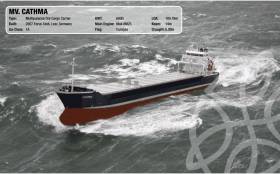Displaying items by tag: Corrib Shipping Group
Cargoship Calls to Capital to Load Concentrates for Dublin Based Group
#Concentrates – It is pleasing to concentrate on an Irish based ship management company that otherwise is not widely documented in mainstream media, writes Jehan Ashmore.
Cathma, a multipurpose dry-cargo carrier with an Ice Class (1A) certification was tracked by Afloat to the vessel's berth in Dublin Port this morning. The 100m long cargoship is managed by Corrib Shipping Group. The Dundrum based group also comprises a number of shipowning companies.
The 6000dwt Cathma as previously reported on Afloat’s ‘Cargoship’ focus discharged fertiliser in Foynes last year, belongs to the Group that was established in 1995. As part of the management team role, they are tasked to employ professional officers and crew to man its vessels.
Cathma is flagged in Curacao, a Dutch island in the Caribbean, is docked in Alexandra Basin along the north side of the 230m Bulk loading jetty. The facility completed in 1967 is served by rail-wagons laden with lead and ore concentrates from Bolidan Tara Mines in Co. Meath.
The loading facility in Dublin Port, which this year is 50 years old, is to be demolished as part of the port’s Masterplan. This involves phase one of a major €230m Alexandra Basin Redevelopment (ABR) project where quayside reconfiguration is underway to accommodate much larger deep drafted ships.
A new bulk-mineral loading facility will be reinstated within the basin.
Corrib Shipping also sail their ships as part of Royal Wagenborg (a Dutch operator of more than 170 ships) that acts as chartering agents for the Irish based group.
In January, Afloat investigated into the details of the 118m Viechtdiep, a 7,200dwt cargoship that was acquired by Corrib to become the group's fifth ship. The vessel was drydocked to emerge as the Dutch flagged Ziltborg operating for Wagenborg.






























































